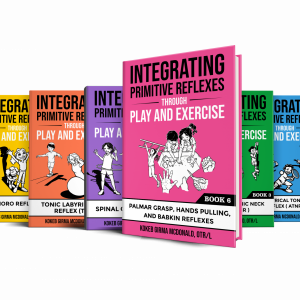Interest in primitive reflexes and treating retained primitive reflexes has expanded greatly in the last 20 years. Researchers and practitioners alike have come to understand the crucial role these reflexes play in the development of children. Understanding primitive reflexes and how they impact a child’s movements and behaviors is essential for us occupational therapists, as it allows us to identify and address underlying motor patterns and brain development that may be impacting a child’s functional skills.
What are primitive reflexes?
Primitive reflexes are innate, automatic movements that are present at birth and are necessary for survival in the early stages of life.
If you’re a parent or you’ve been around small children, you’ve likely seen the grasp reflex—put something in an infant’s hand and they will reflexively close their hand around it—or the rooting reflex—stroke a child’s cheek and they will turn their head toward the touch, searching for food.
These reflexes help an infant to adapt to their environment, by allowing them to suck, grasp, and respond to visual and auditory stimuli, and to protect themselves against threats. They also help to develop the neural pathways that are necessary for more advanced movements and behaviors.
What does it mean when a reflex is “retained?”
As a child develops, these primitive reflexes should “integrate,” or fade away, as the brain matures and the child learns to control their movements. However, in some cases, these reflexes may be retained, meaning they reflexive motion is still present and is done without intention.
These retained reflexes can lead to a range of difficulties, including developmental delays in gross and fine motor skills, difficulties with balance and coordination, and difficulties with attention, concentration, and learning.

What does this mean for occupational therapists?
An occupational therapist is particularly well-suited to identifying and treating retained primitive reflexes, as we work with children to improve motor skills and coordination, and to help them to adapt to their environment. An occupational therapist can screen for retained reflexes, understanding if and how those retained reflexes might affect the functional goals they’ve identified for the client, and then provide exercises designed to reach those functional goals via integrating the retained reflex.
For example, an occupational therapist may work with a child who is struggling with fine motor skills, like those needed for writing in school. Through an assessment, the therapist may identify that the child has a retained grasp reflex, which can make it difficult for them to control their fingers and hands. By providing exercises that target the integration of the grasp reflex, the therapist can help the child gain better control over their fingers and hands, which will improve their fine motor skills and ability to complete tasks that require precise movements. This approach can help the child to achieve a functional goal, such as being able to button their shirt or hold a pencil, and also improve the child’s ability to participate in activities that require fine motor skills, such as drawing and writing.
Addressing functional goals and integrating primitive reflexes—all while having fun!
With our Reflex Integration Through Play™️ screening and treatment method, we use a specialized planning and exercise program that provides a step-by-step process for identifying functional gaps that can be addressed by integrating retained reflexes. We focus on making the exercises fun and easy to do, both in a clinic setting but also at home or at school. This approach helps children to feel more motivated and engaged in their therapy, and to make faster progress in their development. Check out more in our book series.
In conclusion, primitive reflexes play a crucial role in the early stages of life, and their integration is necessary for the development of more advanced movements and behaviors. Retained primitive reflexes can lead to developmental delays and difficulties with motor coordination, balance, and learning. Occupational therapists are in a unique position to identify and treat retained primitive reflexes that affect functional goals and our specialized treatment planning tools within Reflex Integration Through Play are a fun and engaging way to help children improve their function and reach their full potential!
Further Reading
To go in-depth into primitive reflexes, their retention, and how to treat them with play-based exercises, check out our online Certification Program and book series.





